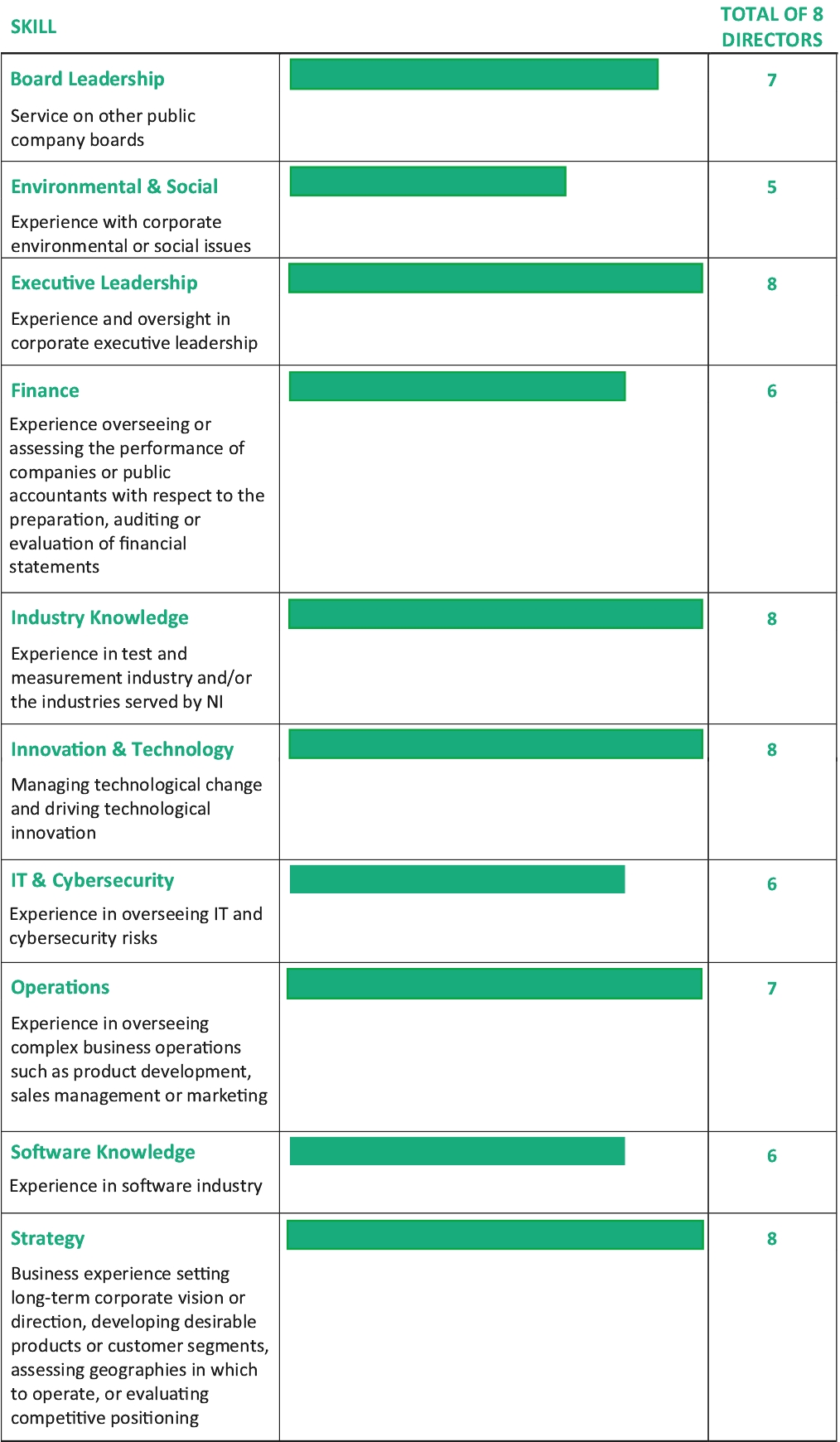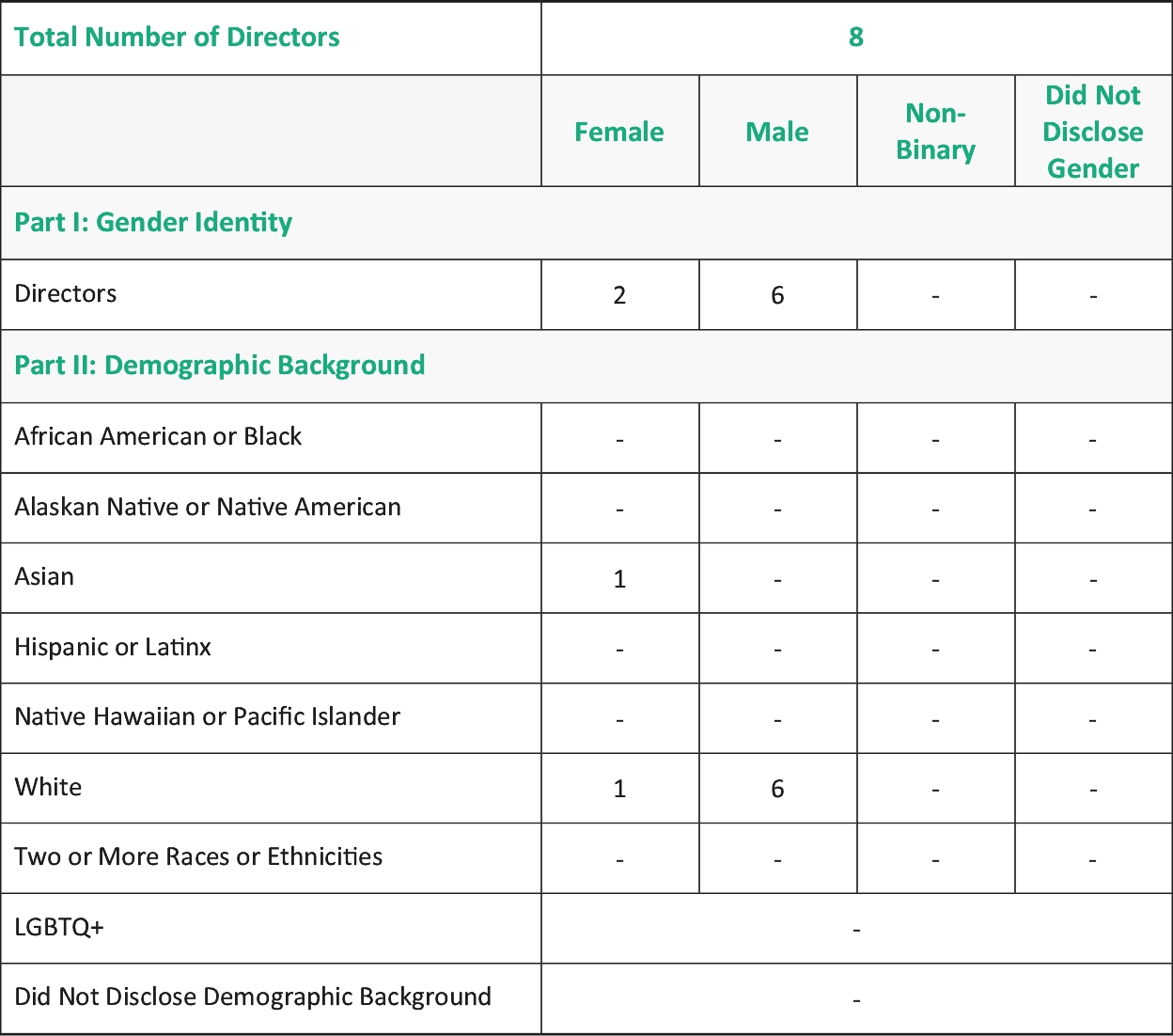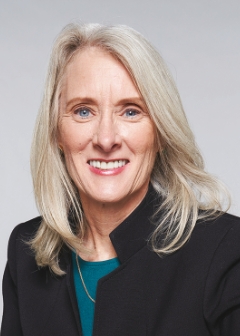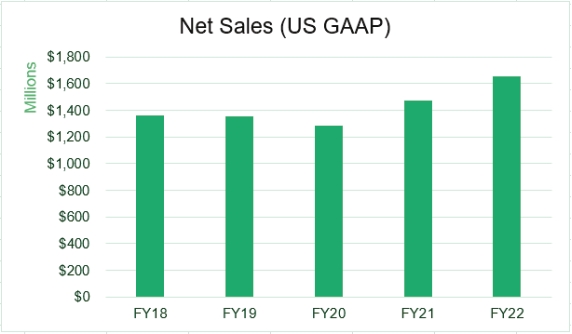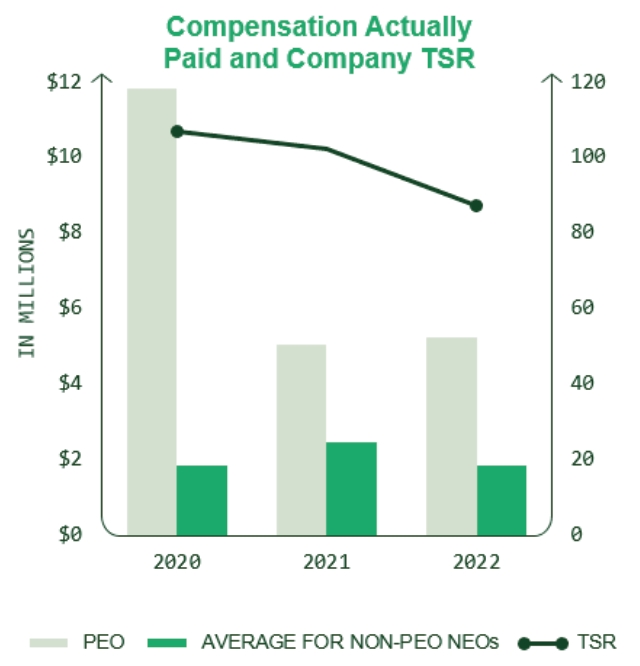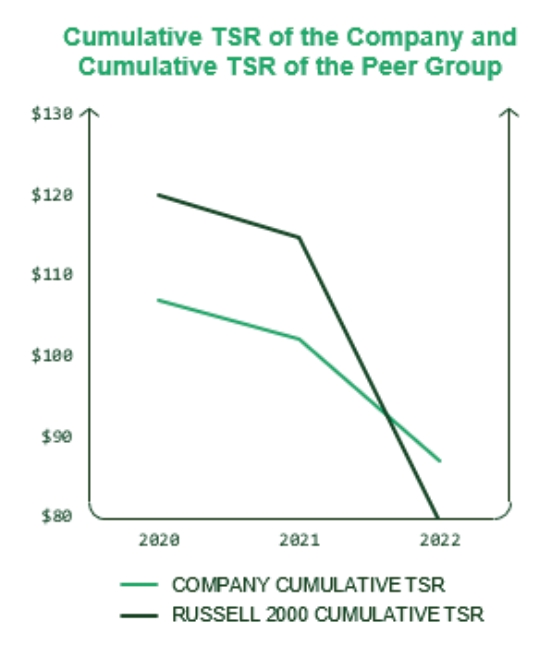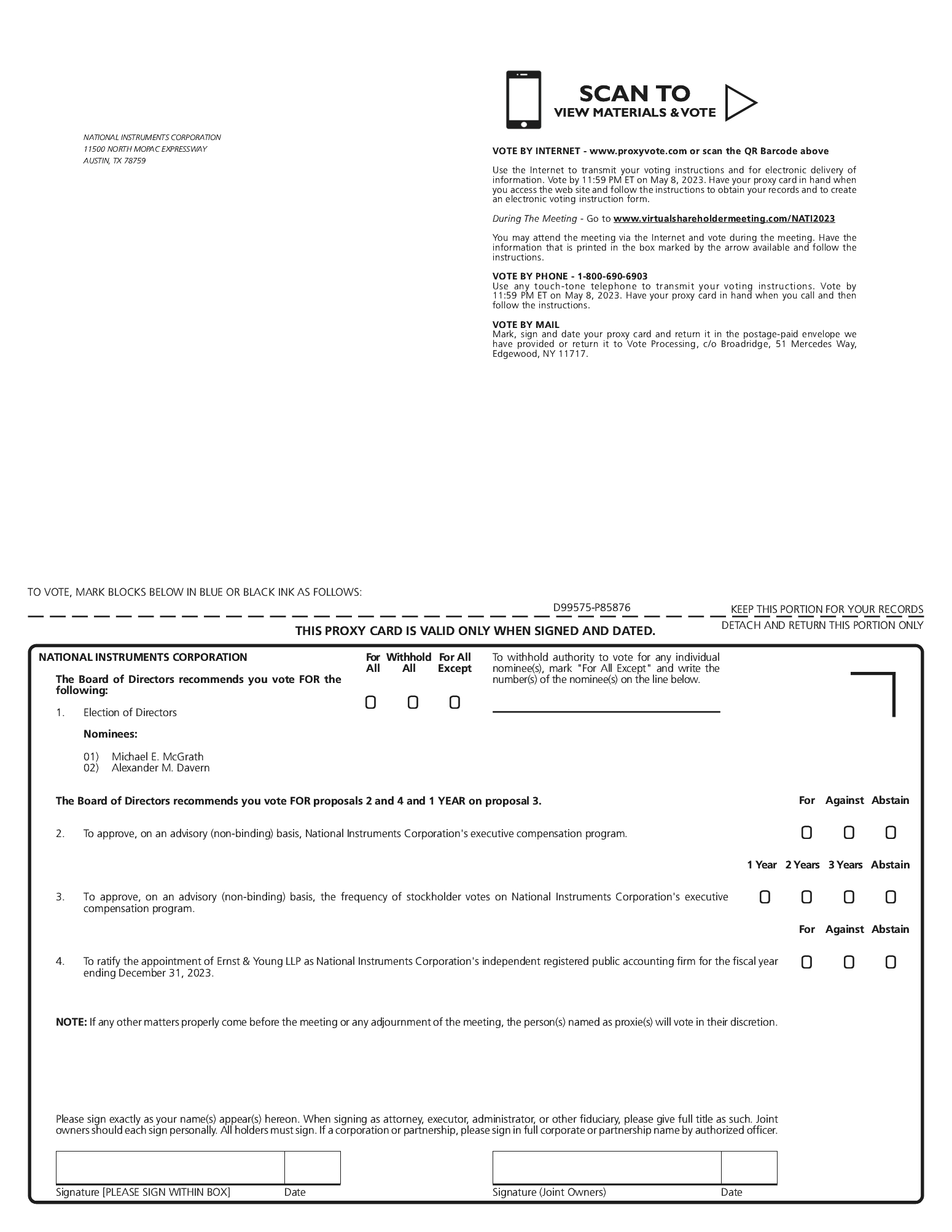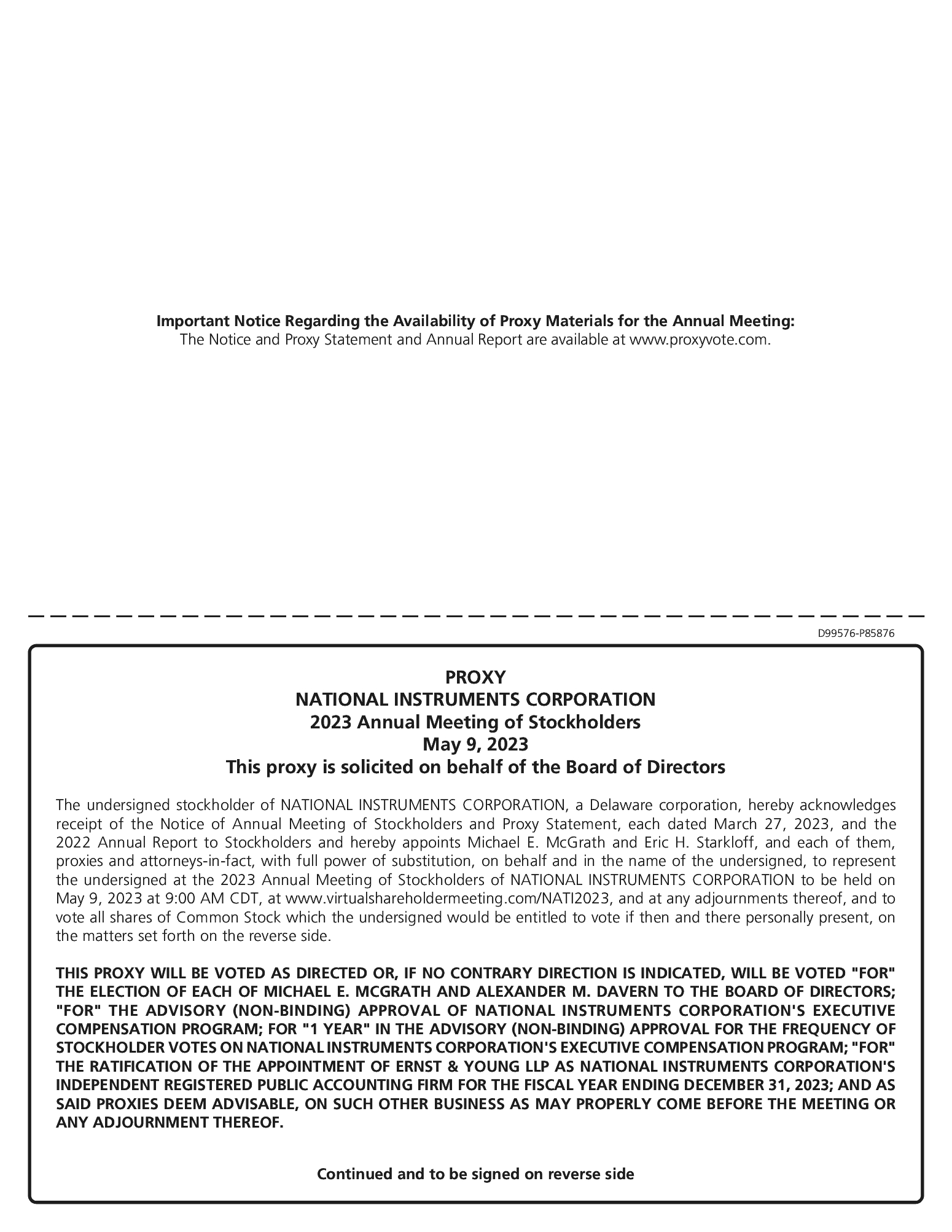SECURITY OWNERSHIP
OF CERTAIN BENEFICIAL OWNERS AND MANAGEMENT
The following table sets forth the beneficial ownership of NI’s common stock as of
the Record DateMarch 13, 2023 (the “Table Date”), unless otherwise indicated, by (i)
by all personseach person known to NI, based
solely on statements filed by such persons pursuant to Section 13(d) or 13(g) of the Exchange Act, to be the beneficial
ownersowner of more than 5% of NI’s common stock, (ii)
by each
of the executive officers namedNamed Executive Officers as defined and set forth in the Summary Compensation Table under “Executive Compensation,” (iii)
by each director and director nominee, and (iv)
by all current directors and
executive officersExecutive Officers as a group:
| | | | | | | | |
| Name of Person or Entity | | Number of
Shares (1) | | | Approximate
Percentage
Owned (2) | |
James J. Truchard 11500 North Mopac Expressway Austin, Texas 78759 | | | 8,067,409 | (3) | | | 6.15% | |
James J. Truchard Marital Trust 3816 Hunterwood Point Austin, Texas 78746 | | | 10,770,347 | (4) | | | 8.21% | |
Janus Henderson Group PLC 201 Bishopsgate United Kingdom EC2M 3AE | | | 11,392,342 | (5) | | | 8.68% | |
The Vanguard Group 100 Vanguard Blvd. Malvern, Pennsylvania 19355 | | | 9,975,549 | (6) | | | 7.60% | |
T. Rowe Price Associates, Inc. 100 E. Pratt Street Baltimore, Maryland 21202 | | | 9,608,560 | (7) | | | 7.32% | |
BlackRock, Inc. 55 East 52nd Street New York, NY 10055 | | | 8,861,057 | (8) | | | 6.75% | |
Wellington Management Company LLP 280 Congress Street Boston, MA 02210 | | | 6,652,396 | (9) | | | 5.07% | |
Jeffrey L. Kodosky | | | 1,895,962 | (10) | | | 1.45% | |
Alexander M. Davern | | | 182,599 | (11) | | | * % | |
Karen M. Rapp | | | 5,635 | (12) | | | * % | |
Eric H. Starkloff | | | 27,186 | (13) | | | * % | |
Scott A. Rust | | | 24,745 | (14) | | | * % | |
John C. Roiko | | | 20,277 | (15) | | | * % | |
Charles J. Roesslein | | | 98,593 | (16) | | | * % | |
Duy-Loan T. Le | | | 93,807 | (17) | | | * % | |
John M. Berra | | | 36,977 | (18) | | | * % | |
Michael E. McGrath | | | 19,681 | (19) | | | * % | |
Gerhard P. Fettweis | | | 7,421 | (20) | | | * % | |
All executive officers and directors as a group (12 persons) | | | 10,480,292 | (21) | | | 7.98% | |
| | The Vanguard Group (3)
100 Vanguard Blvd.
Malvern, Pennsylvania 19355 | | | 13,210,667 | | | 10.05% | |
| | BlackRock, Inc. (4)
55 East 52nd Street
New York, NY 10055 | | | 12,045,874 | | | 9.16% | |
| | Janus Henderson Group PLC (5)
201 Bishopsgate
United Kingdom EC2M 3AE | | | 8,885,010 | | | 6.76% | |
| | T. Rowe Price Investment Management, Inc. (6)
101 E. Pratt Street
Baltimore, Maryland 21201 | | | 8,097,540 | | | 6.16% | |
| | Eric H. Starkloff (7) | | | 269,266 | | | *% | |
| | Karen M. Rapp (8) | | | 103,074 | | | *% | |
| | Scott A. Rust (9) | | | 50,596 | | | *% | |
| | Jason E. Green | | | 27,065 | | | *% | |
| | Ritu Favre (10) | | | 28,206 | | | *% | |
| | Alexander M. Davern (11) | | | 279,850 | | | *% | |
| | Duy-Loan T. Le (12) | | | 121,775 | | | *% | |
| | Michael E. McGrath (13) | | | 47,092 | | | *% | |
| | Gerhard P. Fettweis (14) | | | 33,685 | | | *% | |
| | James E. Cashman, III (15) | | | 21,501 | | | *% | |
| | Liam K. Griffin (16) | | | 21,501 | | | *% | |
| | Gayla J. Delly (17) | | | 18,560 | | | *% | |
| | All current Executive Officers and directors as a group (12 persons)(18) | | | 912,674 | | | *% | |
*
| Represents less than 1% of the outstanding shares of our common stock.stock as of the Table Date. |
(1)
| Except as indicated in the footnotes to this table, the persons named in the table have sole voting and investment power with respect to all shares of common stock shown as beneficially owned by them, subject to community property laws where applicable. |
The number in the “Number of shares of common stock beneficial owned” column represents shares of NI’s common stock held, and the time-based restricted stock units (“RSUs”) held that will vest within 60 days of the Table Date. The number does not include the RSUs that vest more than 60 days of the Table Date. RSUs are awards granted by NI and payable, subject to vesting requirements, in shares of NI’s common stock.
(2)
| For each individual and group included in the table, percentage owned is calculated by dividing the number of shares beneficially owned by such person or group as described above by the sum of (i) the 131,203,627131,496,338 shares of common stock outstanding on March 9, 2018the Table Date, and (ii) the number of shares of common stockRSUs held that such person or group had the right to acquire on orwill vest within 60 days of March 9, 2018, including restricted stock units (“RSUs”).after the Table Date. |
(3)
| Includes 7,535,037Represents shares directlyof NI’s common stock beneficially owned by Dr. Truchard, and 532,372 shares held by anon-profit corporation of which Dr. Truchard is president. |
(4) | The information as to beneficial ownership is based on a Schedule 13G filed with the SEC on February 24, 2015, reflecting beneficial ownership as of December 31, 2014. The Schedule 13G states that the James J. Truchard Marital Trust has sole voting power with respect to 10,770,347 shares of common stock and sole dispositive power with respect to 10,770,347 shares of common stock. |
(5) | The information as to beneficial ownership is based on a Schedule 13G filed with the SEC on February 13, 2018, reflecting beneficial ownership as of December 31, 2017. The Schedule 13G states that Janus Henderson Group PLC and/or its subsidiaries have shared voting power with respect to 11,392,342 shares of common stock and shared dispositive power with respect to 11,392,342 shares of common stock. |
(6) | The information as to beneficial ownership is2022, based on a Schedule 13G/A filed with the SEC on February 9, 2018, reflecting beneficial ownership2023 by The Vanguard Group. The Vanguard Group has shared voting power |







